GALLUP NEWS SERVICE
PRINCETON, NJ -- If the congressional elections were held today, 50% of registered voters would support the Democratic candidate in their district, while 43% would vote for the Republican, according to the latest CNN/USA Today/Gallup survey. The figures are identical to those obtained in an Oct. 21-23, 2005, poll, and only a point different from a Jan. 6-8 poll. Last August, Democrats led by 12 points, 53% to 41%.
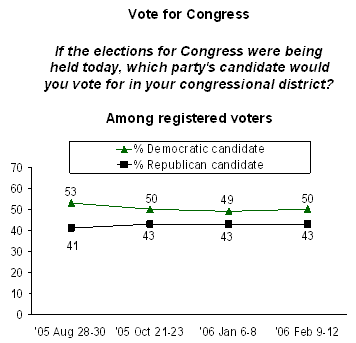
While a seven-point margin would give Democrats majority control of the U.S. House of Representatives if all registered voters actually participated in the 2006 election, it is likely many voters will not do so. Typically, this early in the election year Gallup does not ask the "likely voter" questions that are designed to identify the subset of registered voters (RV) who are most likely to vote. Still, our experience over the past two mid-term elections, in 1998 and 2002, suggests that the RV numbers tend to overstate the Democratic margin by about ten and a half percentage points. Given that Democrats currently lead by seven points that could mean that among people who will definitely vote, Republicans actually lead by three to four points.
Vote compared by Party, Gender, Income, Age, and Region
The poll shows that among the registered voters, 96% of the Democrats and 95% of the Republicans expect to vote for their own party. Independents favor the Democratic candidate by a 17-point margin, 50% to 33%.
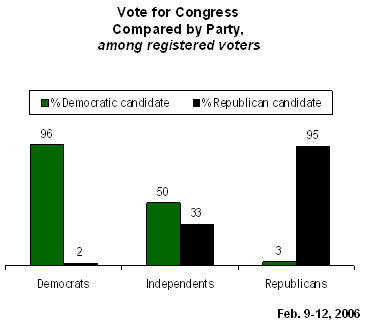
As is typically the case with mid-term elections, there is a significant gender gap. Men prefer the Republicans by a five-point margin, 50% to 45%, while women show a 17-point preference for Democrats, 54% to 37%. In 2002, the gender gap was about the same magnitude.
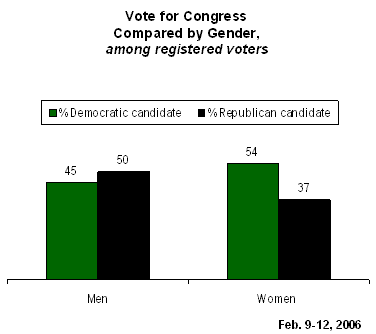
Vote preferences are also quite strongly related to household income. Among registered voters, Democrats win by 62% to 28% among those earning less than $30,000 a year, but enjoy only a 49% to 44% lead among people earning from $30,000 to $50,000 a year. Republicans lead in the two higher income categories, by 11 percentage points in the $50,000 to $75,000 group, and 5 points in the $75,000+ group.
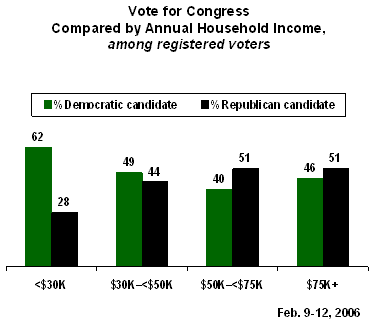
The youngest and oldest voters support Democrats by significant margins -- 29 points among people under the age of 30, and 13 points among people 65 and older. In the two middle-age groups, support for the parties are within four points of each other.
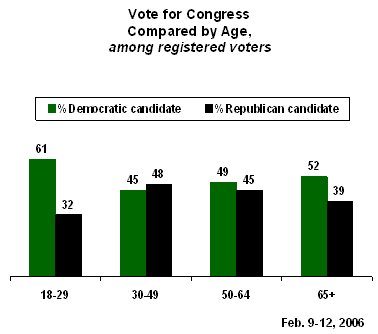
The figures among the oldest age group could be of concern to Republicans, whose drug program for seniors was intended at least in part to help rally support for the GOP. Gallup's last pre-election poll in 2002 showed Republicans winning in this age group among likely voters by about seven percentage points, 51% to 44%. Even among registered voters in the final 2002 pre-election poll, the Democratic lead among the oldest age group was only about half the amount it is now.
According to the current poll, Democrats lead Republicans among registered voters in all four major regions of the country, though only in the East (12-point lead) and the West (9-point lead) are the leads significant. In the Midwest and South, Democrats lead by two and four points, respectively, well within the poll's margin of error.
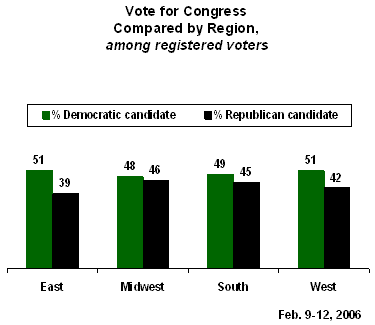
Survey Methods
Results are based on telephone interviews with 898 registered voters, aged 18 and older, conducted Feb. 9-12, 2006. For results based on the total sample of registered voters, the maximum margin of sampling error is ±4 percentage points.
In addition to sampling error, question wording and practical difficulties in conducting surveys can introduce error or bias into the findings of public opinion polls.